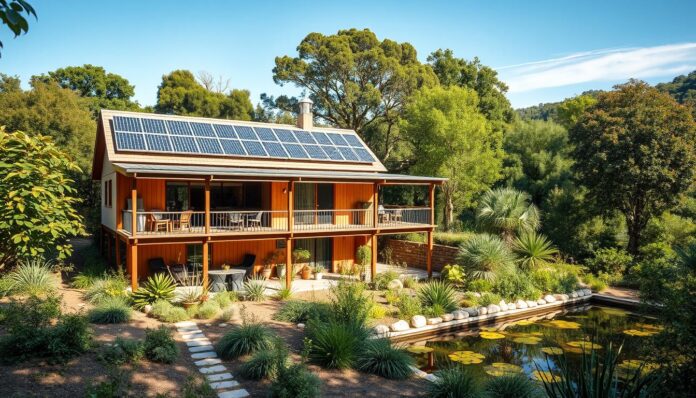More people are looking for permaculture accommodation design that’s good for the planet. About 73% of travelers want places to stay that are eco-friendly. This shows how important sustainable travel experiences are in the tourism world.
Permaculture is a way to design places that are good for the environment. It’s perfect for hotels and resorts. By using permaculture, they can lower their impact on the planet and give guests amazing experiences.
Key Takeaways
- Approximately 73% of travelers prefer accommodation that implements sustainability practices
- Permaculture accommodation design can help reduce energy costs and earn renewable energy credits
- Sustainable travel experiences are becoming a crucial aspect of the tourism industry
- Permaculture principles can help hotels and resorts reduce their environmental footprint
- Eco-friendly vacations are in high demand, making permaculture accommodation design a vital component of the travel experience
- Permaculture accommodation design can provide unique and immersive experiences for guests
- Hotels utilizing solar energy can save over $1,500 in energy costs and earn approximately $16,000 in renewable energy credits annually
Understanding Permaculture Principles
Permaculture is a way to design sustainable places that work like nature. It’s key for making eco-friendly stays and regenerative tourism experiences. It follows three main ethics: caring for the earth, people, and sharing fairly.
The principles of permaculture help us understand nature better. They guide us to make ethical tourism adventures that help the environment and give tourists a special experience. Some important principles are:
- Observing and interacting with nature to enhance understanding
- Using renewable resources and minimizing waste
- Creating diverse and resilient ecosystems
Using permaculture in designing eco-friendly places leads to regenerative tourism. It makes tourism better for the environment and society. This way, tourism can have less harm and be more rewarding for everyone involved.
The Benefits of Permaculture Accommodation
Permaculture accommodation brings many benefits, like using eco-friendly practices. These practices make the stay better for guests. Guests can also join nature tours and green activities, connecting with nature and local people.
This supports sustainable tourism and eco-friendly vacations.
Some main benefits of permaculture accommodation are:
- Less water use and waste
- More organic and local food
- Better biodiversity and ecosystem services
- Helping local communities and economies
Guests can do things like gardening, conservation, and watching wildlife. These activities make vacations more eco-friendly and enriching.
Choosing permaculture accommodation helps the tourism industry be greener. It’s good for the environment and supports local communities. It also helps share cultures.
| Benefits | Description |
|---|---|
| Eco-friendly practices | Less water and waste, more organic and local food |
| Enhanced guest experience | Unique and enriching experiences, like gardening and wildlife watching |
| Community engagement | Support for local communities and economies, cultural exchange promotion |
Types of Permaculture Accommodation
Permaculture accommodations offer a unique way for travelers to connect with nature and local communities. They provide sustainable travel experiences and help the local economy. By joining in permaculture activities, visitors learn about sustainable living and eco-friendly practices.
Examples include eco-lodges, glamping options, and agricultural stays. These places let visitors learn about sustainable farming, renewable energy, and eco-friendly building. It’s a chance to dive into permaculture.
Eco-lodges
Eco-lodges focus on sustainable and eco-friendly stays. They use natural materials and renewable energy. They also manage water sustainably.
Glamping
Glamping offers a luxurious camping experience. It includes solar showers and composting toilets. It lets visitors enjoy nature and outdoor activities.
Agricultural Stay Experiences
Agricultural stays let visitors live on a working farm or ranch. They learn about sustainable farming. It’s a unique way to experience permaculture.
Site Analysis for Permaculture Projects
Site analysis is key in permaculture projects. It helps design systems that are sustainable and regenerative. This step involves looking at land, finding natural resources, and understanding the local climate. It’s like Costa Rica’s way of working with nature, using renewable energy and conserving.
In regenerative tourism, site analysis is vital. It helps create ethical tourism adventures that help the local community and protect the environment. For example, organic farming experiences can use nature’s resources well. This reduces carbon footprint and supports sustainable farming.
Some important things to consider in site analysis are:
- Looking at land features, like soil and terrain
- Finding natural resources, like water and sunlight
- Understanding the local weather, including temperature and rain
By analyzing sites holistically, permaculture projects can build ecosystems that support both people and nature. This method also guides the design of regenerative tourism projects. It makes sure they are sustainable, ethical, and responsible.
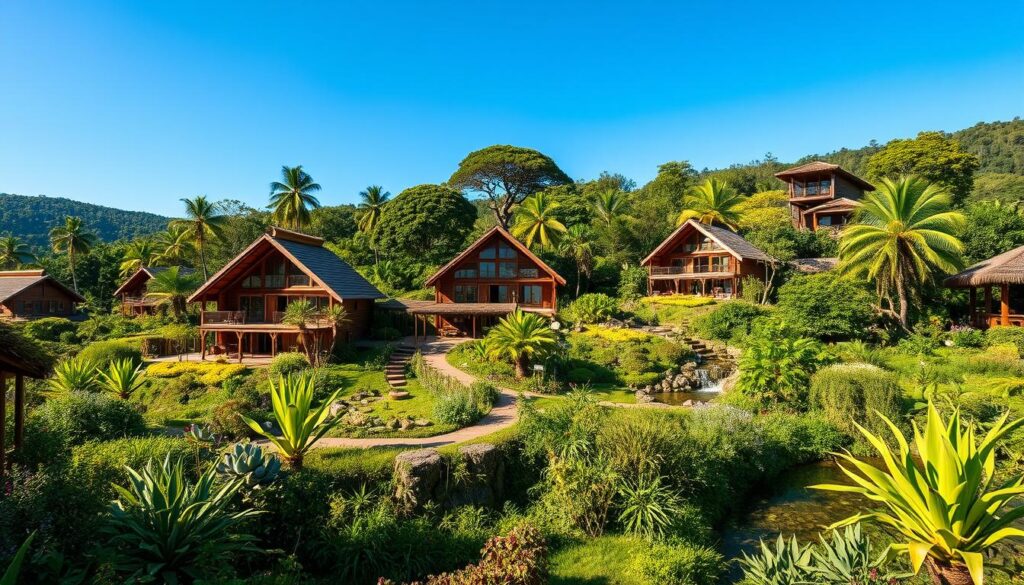
| Category | Description |
|---|---|
| Land Characteristics | Soil type, topography, and vegetation |
| Natural Resources | Water sources, solar exposure, and wind patterns |
| Local Climate | Temperature, precipitation, and humidity patterns |
Designing Sustainable Structures
Designing sustainable structures for eco-friendly vacations is key. We must think about the environmental impact of materials and energy use. Activities like hiking and birdwatching are better with sustainable travel that cares for the environment and local people.
Important aspects include using recycled materials, energy-saving systems, and water management. For instance, passive solar design can cut heating and cooling energy use by up to 30%. Also, building with recycled materials can cut waste by up to 80%.
To make travel experiences truly sustainable, we must add eco-friendly practices to design. This means using local materials, saving water, and using renewable energy. This way, we can offer green travel that’s good for the planet and enriching for visitors.
Benefits of sustainable structures include:
- Less carbon emissions
- Lower energy use
- More natural resource conservation
By focusing on eco-friendly vacations and green travel, we can make tourism better for the environment and local communities. This leads to more sustainable travel experiences for everyone.
Incorporating Natural Landscaping
Permaculture tourist activities often include nature-based tours. These tours let visitors see the beauty of natural landscapes. Immersive permaculture experiences can be made by adding natural landscaping to permaculture places. This includes designing gardens, creating wildlife habitats, and using edible landscaping.
Some benefits of natural landscaping in permaculture places are:
- Enhanced aesthetic appeal
- Increased biodiversity
- Opportunities for immersive permaculture experiences
Rancho Margot is a resort that shows high sustainability through permaculture. It uses natural landscaping in its accommodations. This lets visitors see nature’s beauty and learn about sustainable living.
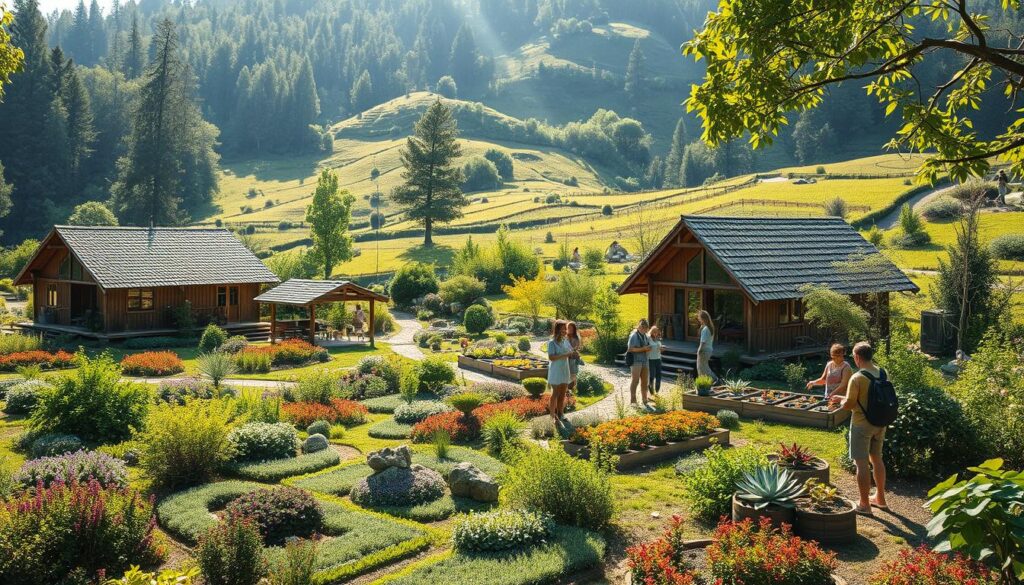
Permaculture garden designs can make landscapes both beautiful and useful. They offer chances for nature-based tours and deep permaculture experiences. By adding natural landscaping to permaculture places, visitors can enjoy nature and learn about sustainability.
| Benefits of Natural Landscaping | Description |
|---|---|
| Enhanced aesthetic appeal | Increased beauty and attractiveness of the landscape |
| Increased biodiversity | Support for a wide range of plant and animal species |
| Opportunities for immersive permaculture experiences | Hands-on learning experiences for visitors |
Integrating Renewable Energy Solutions
Renewable energy is key in permaculture places, helping them use less non-renewable energy. This helps with regenerative tourism, which tries to make tourism less harmful to the planet. Using solar, wind, and biogas, these places can cut down their environmental harm a lot.
Examples of renewable energy in permaculture places include solar panels, wind turbines, and biogas systems. These can meet up to 75% of energy needs in places without a grid. Also, adding organic farming experiences and ethical tourism adventures makes these places even greener.
Here are some good things about using renewable energy in permaculture places:
- Less carbon footprint
- More energy saved
- Better air quality
- More regenerative tourism practices
By using renewable energy, permaculture places help make the future greener. They support regenerative tourism and ethical tourism adventures. This not only helps the planet but also makes guests’ stays better, offering chances for organic farming experiences and learning about green living.
| Renewable Energy Solution | Benefits |
|---|---|
| Solar Power | Less carbon footprint, more energy saved |
| Wind Energy | Better air quality, more regenerative tourism practices |
| Biogas | Less waste, more energy saved |
Creating Sustainable Water Systems
For those looking for eco-friendly vacations, sustainable water systems are key. Using rainwater harvesting, greywater recycling, and natural filters can cut down water use. This makes green travel activities better for the planet.
Rainwater harvesting is a top way to save water. It lets permaculture places collect and store rainwater, lessening their need for city water. Plus, using greywater to water plants and flush toilets cuts down water use even more.
Rainwater Harvesting Techniques
Rainwater harvesting collects and stores rainwater for uses like watering plants and flushing toilets. It’s great in rainy areas, helping to save city water and making eco-friendly vacations greener.
Greywater Recycling
Greywater recycling uses wastewater from sinks, showers, and washing machines for irrigation and other non-drinking uses. It greatly reduces water use, making green travel activities more eco-friendly and supporting sustainable travel experiences.
Community Involvement in Design
Community involvement is key in permaculture accommodation design. It makes sure the places are not just green but also good for the local people. By working with locals and artisans, permaculture tours offer deep experiences. This also boosts the local economy and keeps nature safe.
Some important things to think about for community involvement in design are:
- Collaborating with local artisans to create unique and sustainable accommodations
- Engaging local residents in the design process to ensure that the accommodations meet their needs and expectations
- Building a sustainable economy by supporting local businesses and promoting nature-based tours and permaculture tourist activities
By focusing on community involvement, permaculture places offer more than just a stay. They help the local community and support green tourism. This way, they make a positive difference on the planet and give tourists special experiences.
| Community Involvement | Benefits |
|---|---|
| Collaboration with local artisans | Unique and sustainable accommodations |
| Engagement with local residents | Accommodations that meet local needs and expectations |
| Support for local businesses | Development of a sustainable economy |
Permaculture Regulations and Certifications
As more people seek regenerative tourism and ethical adventures, permaculture places must follow rules and get certified. This shows their dedication to the environment. It also draws in travelers who want eco-friendly stays, like organic farms.
Understanding Local Zoning Laws
It’s key for permaculture spots to know local zoning laws. They must follow rules on land use, building codes, and protecting the environment.
Permaculture Certification Programs
Permaculture certifications, like the 5 Leaves program, highlight sustainable tourism. They set standards for permaculture places to follow. These programs check if places meet high sustainability and care for the environment standards.
Eco-labels and Their Importance
Eco-labels are vital for promoting green tourism. They show an accommodation’s green commitment. This helps travelers choose wisely. Well-known labels include the International Ecotourism Society’s and the Global Sustainable Tourism Council’s.
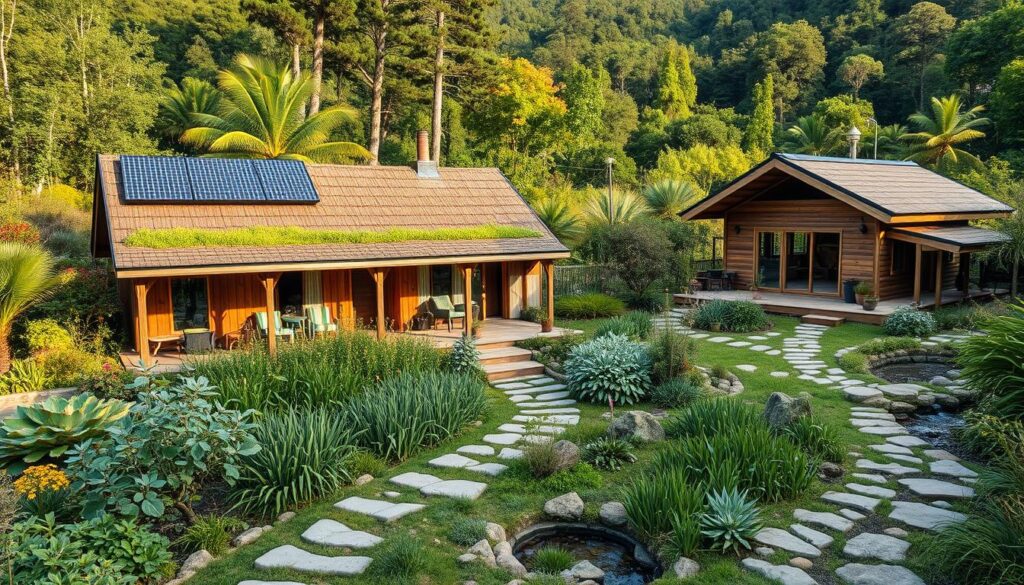
| Certification Program | Description |
|---|---|
| 5 Leaves designation | Recognizes sustainable tourism practices |
| International Ecotourism Society’s Ecotourism Certification | Promotes responsible tourism practices |
| Global Sustainable Tourism Council’s Certification | Ensures sustainable tourism practices |
Marketing Permaculture Accommodation
Marketing permaculture accommodations means focusing on sustainability. Many travelers want eco-friendly vacations and green travel activities. They look for experiences that are unique and good for the environment.
By pointing out the sustainable aspects of permaculture places, like using renewable energy and organic farming, you can draw in eco-aware travelers. This group is growing and looking for places that care about the planet.
To market permaculture places well, know who you’re talking to. Sustainable travel experiences are now popular, not just for a few. People want real, nature-connected experiences that also help local communities.
Use digital tools and social media to reach more people. This way, you can show off what makes permaculture places special.
- Emphasizing the green features and practices
- Reaching out to eco-conscious travelers on social media and online ads
- Showing off unique experiences and activities online
Using these methods, permaculture places can stand out. They can attract travelers who want sustainable travel experiences that help the planet.
Challenges in Permaculture Accommodation Design
Designing permaculture accommodations is a complex task. One big challenge is the high initial cost. This is because sustainable materials and energy-efficient systems are needed.
Regulatory hurdles are also a big challenge. Zoning laws and building codes often don’t align with permaculture principles. This can make it hard to start a project.
Another challenge is community resistance. This can happen when people don’t understand permaculture or worry about its impact. To overcome this, it’s key to engage with the local community and teach them about permaculture’s benefits.
By doing this, designers can create experiences that help the environment and the community. This way, permaculture accommodations can offer unique and sustainable tourism experiences.
Some of the challenges in permaculture accommodation design include:
- High initial investment costs
- Regulatory hurdles and zoning laws
- Community resistance and lack of understanding
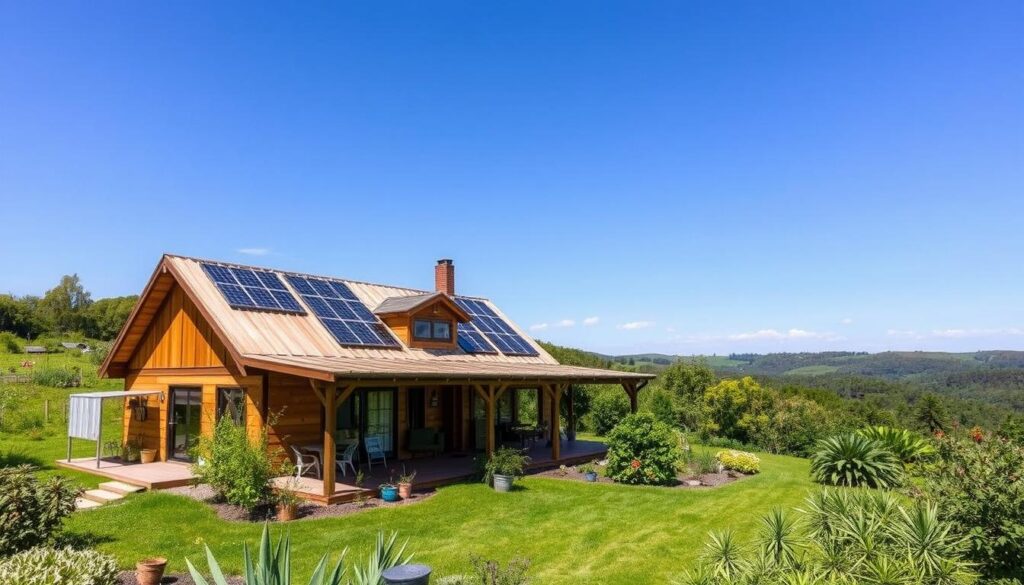
Understanding these challenges helps designers create permaculture accommodations. These accommodations provide unique and regenerative tourism experiences. They also promote sustainable living and community engagement.
Future Trends in Permaculture Tourism
The future of permaculture tourism looks bright, thanks to new tech, a rise in eco-travel, and policy changes. More people want to travel ethically and learn about organic farming. This means big growth for the industry.
New tech like renewable energy and better waste management will make permaculture stays greener. Places like Costa Rica, with over 50% forest and a PES system, show the way forward. They inspire us to make tourism better for the planet.
More people want to slow down and enjoy rural life, which boosts demand for permaculture stays. They want comfort and to connect with nature while helping local areas. By using permaculture, these places offer a unique, green travel experience.
As laws get greener, permaculture tourism will boom. It will bring jobs and help the planet. This is good news for everyone who loves the earth.

